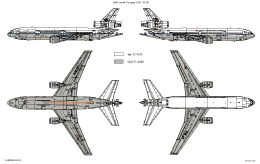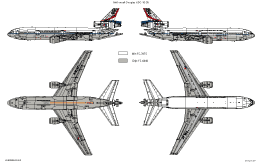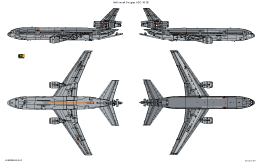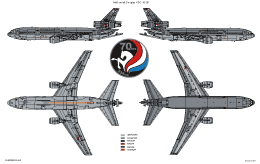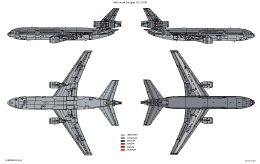Nederlandse Modelbouw en Luchtvaartsite
Dutch Modelling and Aviation
McDonnell-Douglas (K)DC-10-30
History
The McDonnell Douglas DC-10, the first design after the merge of McDonnell and Douglas in 1967, is the successor to the Douglas DC-8. In intended to transport more passengers over longer distances than the DC-8.
It incorporated a wider hull with an increased capacity and because of the use of more powerful engines, the aircraft was equipped with three instead of four engines thus reducing maintenance costs.
In 1968, American Airlines placed the first orders for twenty-five aircraft, soon followed by an order from United Airlines for thirty aircraft plus an option for another thirty aircraft.
The first flight was conducted with a DC-10-10 on August 29, 1970. This first aircraft type had a usual two-class layout for passengers, with a range of about 6100 km.
There was also a DC-10-10CF variant available (which could be used for both passenger and freight transport) and a DC-10-15 variant which was equipped with more powerful engines to be used in areas with high temperatures and / or great heights.
The subsequent DC-10-30 and DC-10-40 versions were intended for international flights and had a considerably extended flight range (10.010 km) as well as a third landing gear because of the heavier take-off weight.
A version with an even larger flight range, the DC-10-50, was designed but never built.
The production of the DC-10 stopped in 1989, with 386 aircraft delivered for airlines and 60 aircraft for the US Air Force.
The DC-10 was succeeded by the McDonnell Douglas MD-11, which mainly has a larger capacity.
Although the last commercial flight of the DC-10 took place in February 2014, cargo versions are in use. Despite the popularity of the type, only a few have been preserved in museums and other examples are kept in storage. Some DC-10s are also used for specific purposes, such as the Orbis International Flying Eye Hospital, which has a compartment where eye operations can be performed.
Versions.
- McDonnell Douglas DC-10-10:
- first version for transport of passengers only; 122 examples built between 1970 and 1981
- McDonnell Douglas DC-10-10CF : Hybrid version suitable for transport of both cargo and passengers of which eight are built.
- McDonnell Douglas DC-10-15:
- passenger version with more powerful engines intended for use in areas with higher temperatures and / or at higher altitudes; seven examples built between 1979 and 1983.
- McDonnell Douglas DC-10-20:
- proposed passenger version of the DC-10-10 with additional fuel tanks, 0.9 m extension of each wing and an extensive landing gear (rear, middle). The type would be equipped with three Pratt & amp; Whitney JT9D-15 turbofan engines with an output of 203 Kn; the maximum take-off weight increased to 240,400 kg. However, improvements in engines led to more power and a higher take-off weight. Northwest Orient Airlines requested the type designation to be adjusted in DC-10-40, to make the improvements over the previous version clearer.
- McDonnell Douglas DC-10-30:
- Passenger version built between 1972-1988.
- McDonnell Douglas DC-10-30CF : Hybrid version suitable for both freight and passenger transport; built from 1973.
- McDonnell Douglas DC-10-30ER : Passenger version built from 1981.
- McDonnell Douglas DC-10-30AF : Freight version built from 1984.
- McDonnell Douglas DC-10-40:
- Passenger version, built between 1973-1983
Original DC-10-20, at the insistence of NorthWest Airlines renamed to DC-10 -40. - McDonnell Douglas DC-10-50:
- Unrealized passenger version.
Tanker versions
- McDonnell Douglas KC-10 Extender:
- 60 examples, converted from DC-10-30CF, destined for USAF.
- McDonnell Douglas KDC-10:
- Four examples, converted from DC-10-30CF
Two examples converted for RNlAF and other examples for Omega Aerial Refueling Services and Global Airtanker Service.
Advanced Tanker Cargo Aircraft Program
Doubts arose in the Vietnam War about the effective use of the Boeing KC-135 Stratotanker for the USAF. A tanker aircraft with larger capacity than the KC-135 was needed, because both aircraft in Southeast Asia and domestic aircraft had to be supplied with fuel. In 1972 two DC-10s and a Boeing 747 flew to Edwards Air Force Base, with the aim of simulating refueling in the air and thus determining the suitability of the aircraft.
During the Yom Kippur war in 1973, USAF operation Nickel Grass began to provide Israel with arms and supplies. The need for fuel supply in the air became noticeable because the C-5 Galaxy had to fly with less cargo due to the lack of landing rights in Europe. In order to eliminate this restriction in flight freedom, four aircraft were evaluated in 1975: the Lockheed C-5, the Boeing 747, the McDonnell Douglas DC-10, and the Lockheed L-1011. The only serious contenders were Boeing and McDonnell Douglas and on December 19, 1977 the McDonnell Douglas DC-10 was chosen. The main reason was the ability of the DC-10 to take off from shorter runways. After a first order of twelve aircraft, this number was later expanded to sixty.
KC-10 Extender
These so-called KC-10 Extenders flew for the first time on 12 July 1980, but it was not until October of the same year that the first fuel supply was carried out in the air. The design of the KC-10 is based on the DC-10-30CF. Unnecessary features for passenger transport were removed, and the aircraft was equipped with advanced freight transport facilities and military equipment.
The most important adjustments were the addition of a fuel hose (Advanced Aerial Refueling Boom) and additional fuel tanks in the cargo compartments below decks. The extra tanks increased the fuel capacity to 161.488 kg, reaching nearly double the KC-135. The KC-10 has both a fuel hose in the middle under the fuselage and a flexible dry-and-hose system.
The control center for refueling is located at the back of the unit, with a large window for keeping an eye on the refueling. The boom operator controls the process by means of a digital fly-by wire system. Unlike the KC-135, the KC-10's and-drogue system is capable of refueling both US Navy, Marine Corps, and most allied aircraft in the same mission.
Other adjustments included the removal of most side windows and lower cargo doors.
In addition to its function as a tanker plane, the KC-10 can carry up to 66.225 kg of freight (or 77.110 kg when the aircraft is specifically equipped for cargo). The KC-10 has a cargo door on the side for loading and unloading cargo. An external lift system is required for in and out.
Despite all the changes, the KC-10 content remained 88% identical to the DC-10-30CF.
| Dimensions: | |||
| Length: | 55,4 m | Wingspan: | 50,4 m |
| Height: | 17,1 m | Wing area: | - m2 |
| Weights: | |||
| Empty weight: | 122567 kg | Max. start weight: | 259459 kg |
| Performances: | |||
| Max. speed: | 982 km/hr | Climbing speed: | - m/min |
| Cruising speed: | 908 km/hr | ||
| Range: | 10010 km | Service ceiling: | 12802 m |
| Miscellaneous: | |||
| Engine type: | Three General Electric GE CF6-50C2 rated 23814 kg thrust each | ||
| Crew: |
At least a crew of four:
|
||
| Armament: | None | ||
KDC-10 employed by the KLu
Both Dutch KDC-10's are used for refuelling and transport. They are stationed at Eindhoven Airport, at 334 Squadron. Of the 5500 flight hours in the first three years, the aircraft were used for half of the time as tankers. In addition to the commitment to the air force and NATO allies, the KDC-10s are also used for peace missions and humanitarian aid operations. In the first three years 32% of flight hours were spent on this.
Yugoslavia
The two Dutch KDC-10 tankers flew from the 6th of November 1996 on average three times a week to the Adriatic Sea to fuel IFOR aircraft in the air. The IFOR, a peacekeeping force led by NATO, was to monitor compliance with the cease-fire and to respect the border between the Serbian and Muslim-Croatian powers by both parties.
IFOR came up with violence if hostilities would break out again. The first deployment of the KDC-10s during the operation was Decisive Endeavor . The Operation Decisive Endeavor was transferred to the Deliberate Guard operation on 20 December 1996. On 15 June 1998, the name of the operation was changed to Deliberate Forge .
NATO decided in December 2000, following the normalization of air traffic over Bosnia-Herzegovina, to reduce the strength of the BKAC from 41 to 22 aircraft. Belgium and the Netherlands halved their contribution of fighter aircraft, which reduced the deployment of the KDC-10. However, NATO could call on a KDC-10 and an F-60 for the transport of wounded.
Pakistan - South Asia Survey 2005
The Royal Netherlands Air Force was closely involved in assisting the victims of the earthquake in South Asia on 26 December 2005. A KDC-10 of the Royal Netherlands Air Force was first deployed to transfer injured Dutch tourists to their home country. The KDC-10 returned during New Year's Eve.
On Monday, January 3, 2005, a C-130 Hercules left for Estonia to pick up an emergency hospital and a medical team from the Red Cross. The next day this emergency hospital was transferred to a KDC-10, which flies to Indonesia with twenty tons of relief supplies.
The KDC-10 first flew to Medan where the emergency hospital and the medical team were unloaded. After this the aircraft flew to Batan to unload the twenty tons of relief goods. The KDC-10 subsequently loaded 25 tons of relief supplies in Karachi (Pakistan). These goods were finally delivered in Colombo (Sri Lanka). The plane returned to Eindhoven Air Base the same week.
Haiti (2010)
On Thursday morning, January 14, 2010, a KDC-10 departed from Eindhoven Air Base to Haiti. On board was a rescue team that would help track down people buried under the rubble in an area hit by the earthquake.
Other deployments
In the past, the KDC-10 has been used, among other things, for the transport of relief goods and medicines in the Sumatra, Pakistan and Iran, which were hit by natural disasters. The transport plane also evacuated Dutch people from Lebanon in 2006 when a conflict broke out there.
The aircraft were deployed during the Kosovo crisis to evacuate refugees, to the Caribbean and America to offer assistance after hurricanes Luis, Georges and Mitch, and to various countries in Africa and Asia to provide development assistance. In 1998, the aircraft were used to evacuate Dutch from Indonesia during the fall of Suharto. Dutch KDC-10s operated from Manas Air Base in Kyrgyzstan to support Allies during Operation Enduring Freedom .
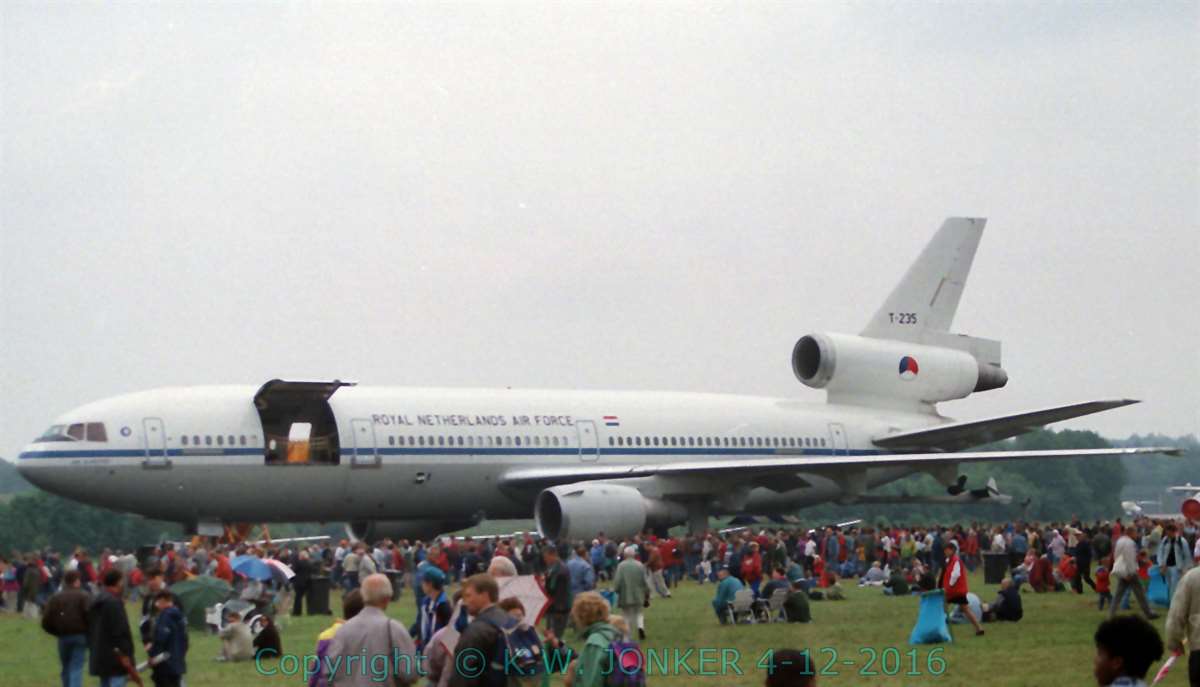
McDonnell-Douglas (K)DC-10, T-235, photographed in June 1996 at the Open Day Dutch Air Force at airbase Twenthe.
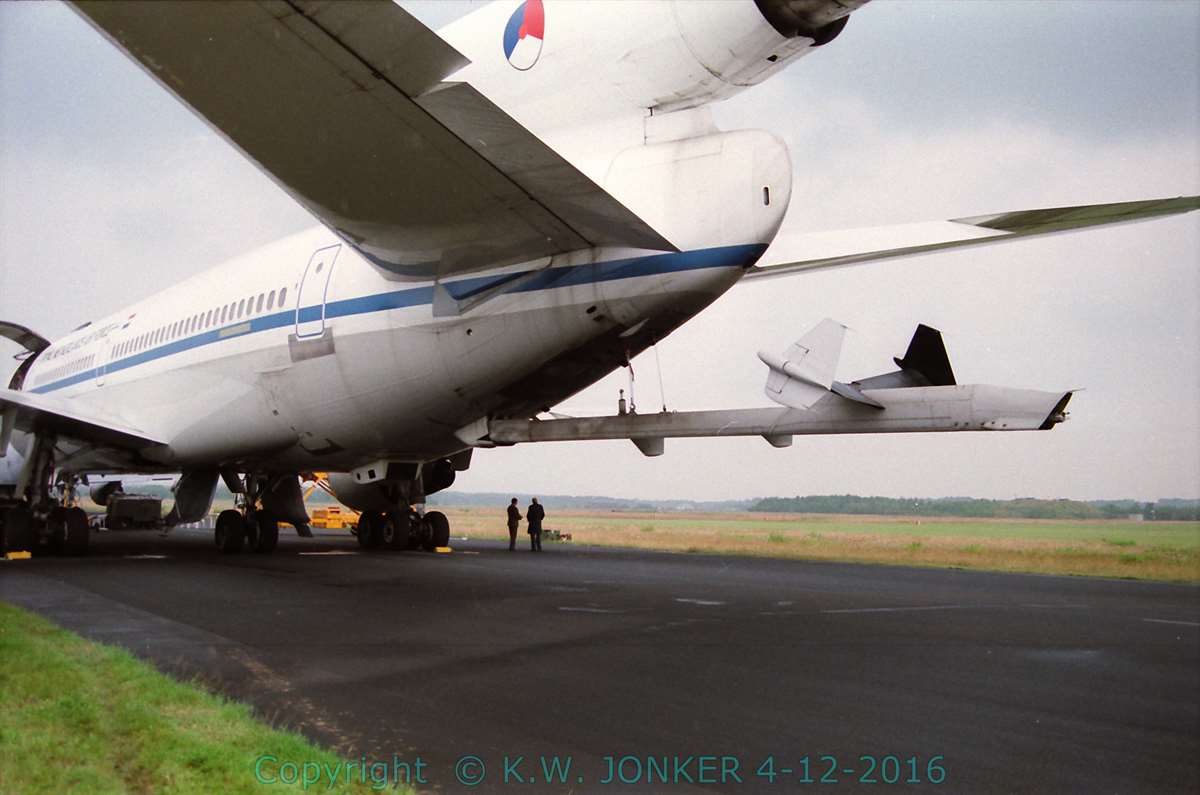
McDonnell-Douglas (K)DC-10, T-235, photographed in June 1996 at the Open Day Dutch Air Force at airbase Twenthe.
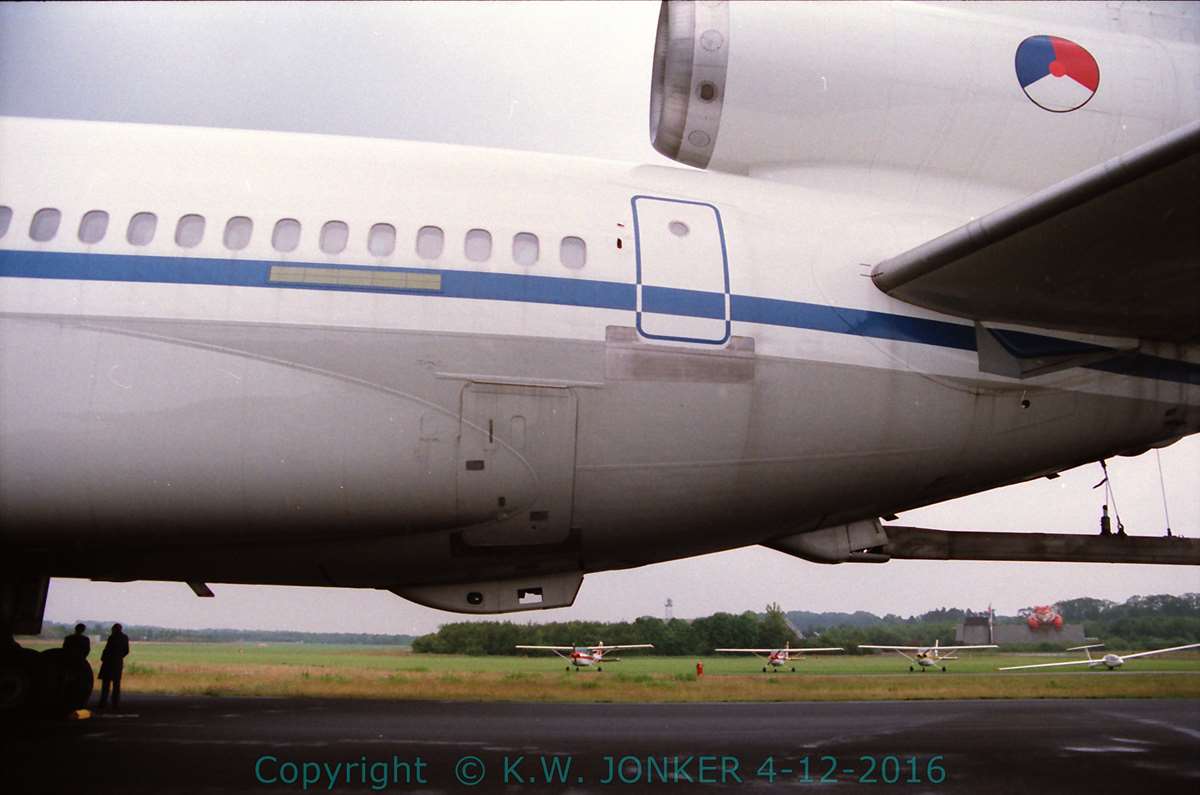
McDonnell-Douglas (K)DC-10, T-235, photographed in June 1996 at the Open Day Dutch Air Force at airbase Twenthe.
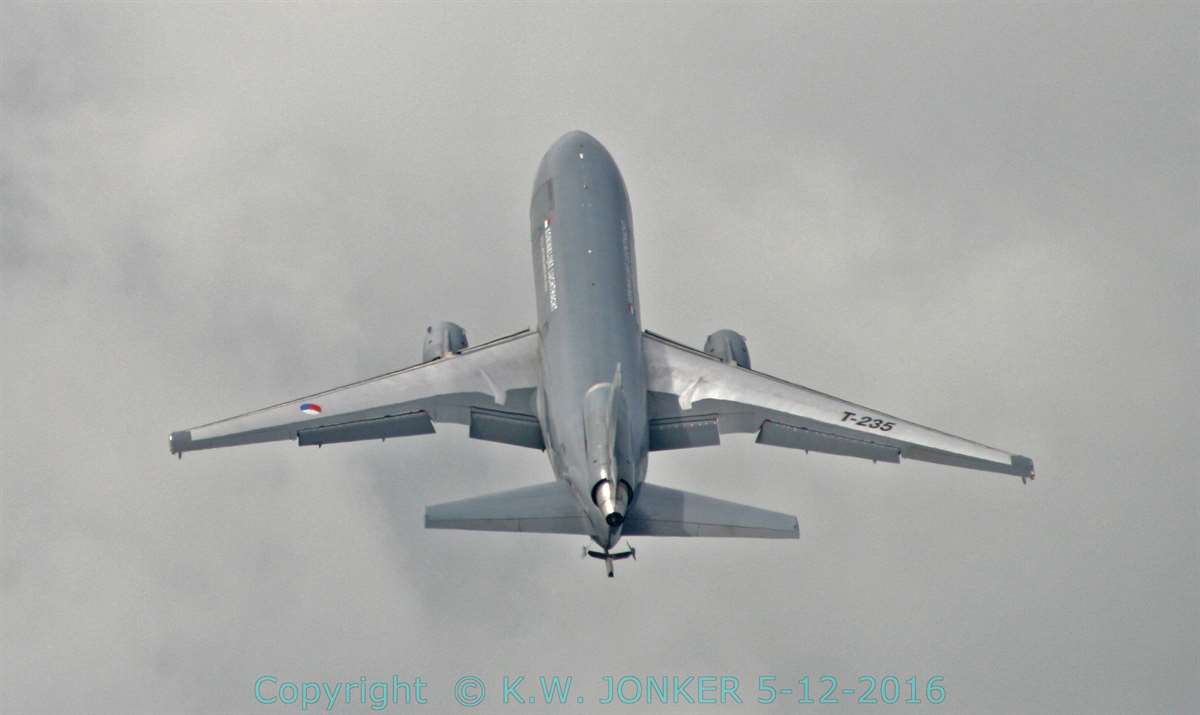
McDonnell-Douglas (K)DC-10, T-235, photographed in June 2008 at the Open Day Dutch Air Force at airbase Leeuwarden.
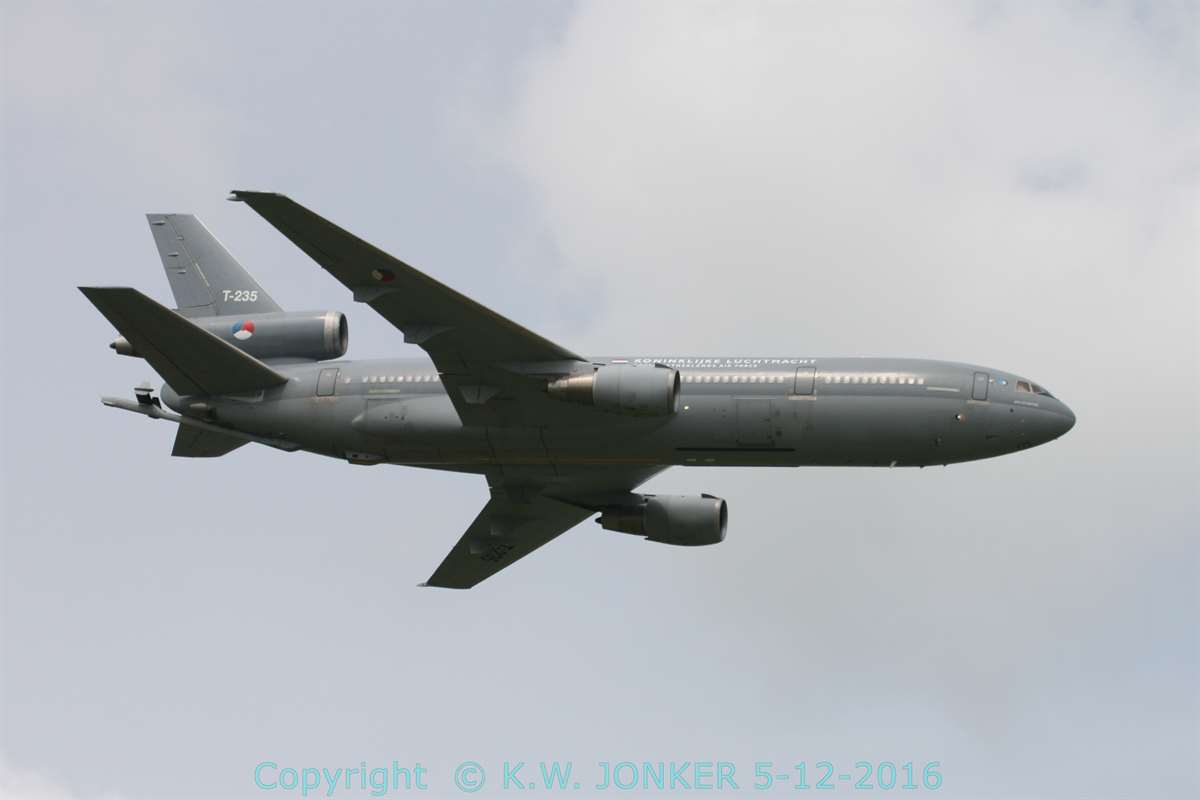
McDonnell-Douglas (K)DC-10, T-235, photographed in June 2008 at the Open Day Dutch Air Force at airbase Leeuwarden.

McDonnell-Douglas (K)DC-10, T-235, photographed in June 2014 at the Open Day Dutch Air Force at airbase Gilze-Rijen. Note the 70 Years 334 Squadron marking on the tail. Also the earlier white markings are replaced by black ones.
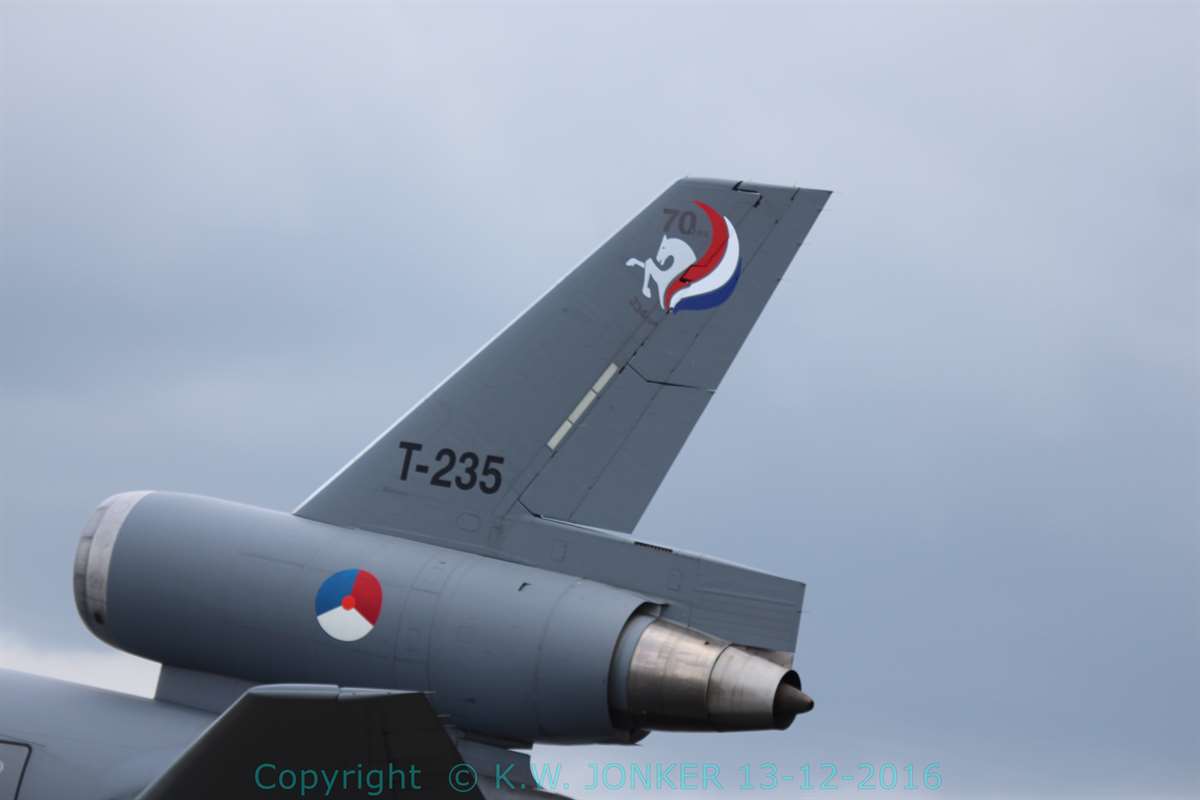
McDonnell-Douglas (K)DC-10, T-235, photographed in June 2014 at the Open Day Dutch Air Force at airbase Gilze-Rijen.
Last flight of the DC-10 cargo transporter, T-255. Left for England to be scrapped.
Posted by Koninklijke Luchtmacht on wednesday April 16, 2014
| Serial | Construction nr. | Date in service | Date out of service | Notes |
|---|---|---|---|---|
| T-235 | 46956 | 12-12-1995 | KDC-10-30CF; Taken over from Martinair; ex PH-MBP | |
| T-264 | 46985 | 29-09-1995 | KDC-10-30CF; Taken over from Martinair; ex PH-MBT | |
| T-255 | 46987 | 2007 | 2013 |
DC-10-30CF; ex N105WA; e N1858U Scrapped summer 2014 |
Hasegawa released several years ago a kit of a KDC-10-30 in 1/200 scale. This release contained an ordinary DC-10 kit plus additional decals for an RNlAF aircraft plus resin tanker parts.
It is possibly to convert a DC-10-30 kit to a KDC-10.
- Transport Wings
- Kit 72-018-001: A vacu formed kit of a Douglas DC-10-30
- Kit 72-018-002: A vacu formed kit of a Douglas KC10A Extender (USAF)
- Anigrand
- Kit 2094: A resin kit of a Douglas KC-10A Extender
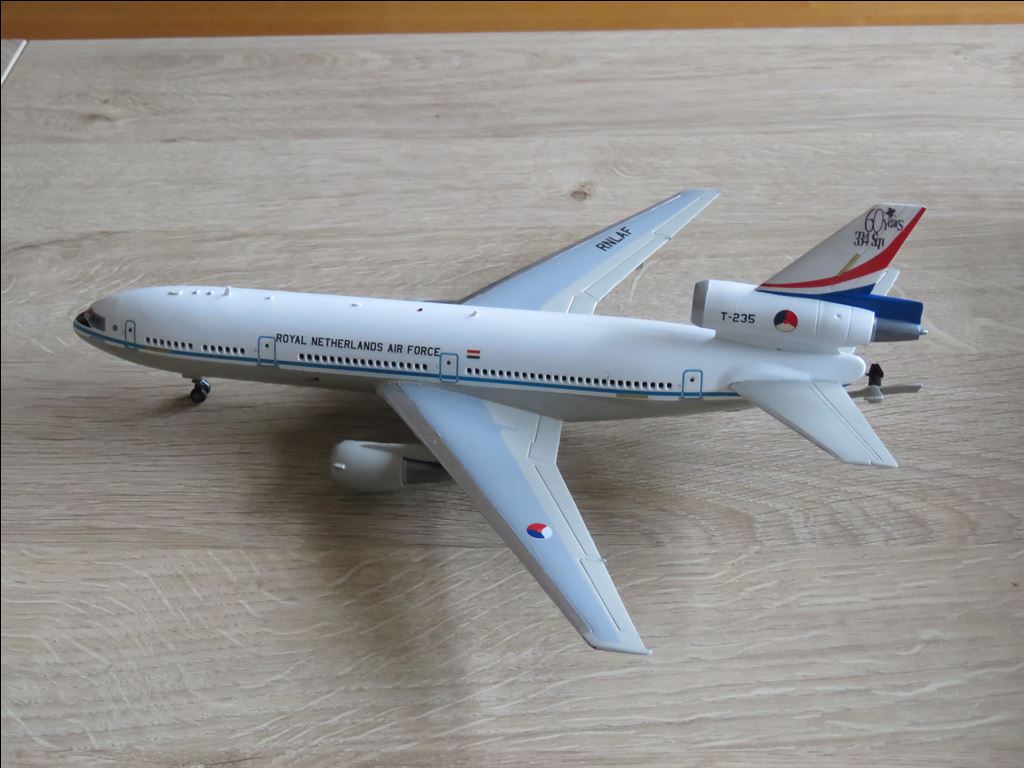
McDonnell-Douglas KDC-10: The Hasegawa model in scale 1/200;
Partly built by me spring 2017 and completed, that is especially fitting antennas, chassis and decals and painting by L. Charmant, for which my heartfelt thanks..
Partly built by me spring 2017 and completed, that is especially fitting antennas, chassis and decals and painting by L. Charmant, for which my heartfelt thanks..
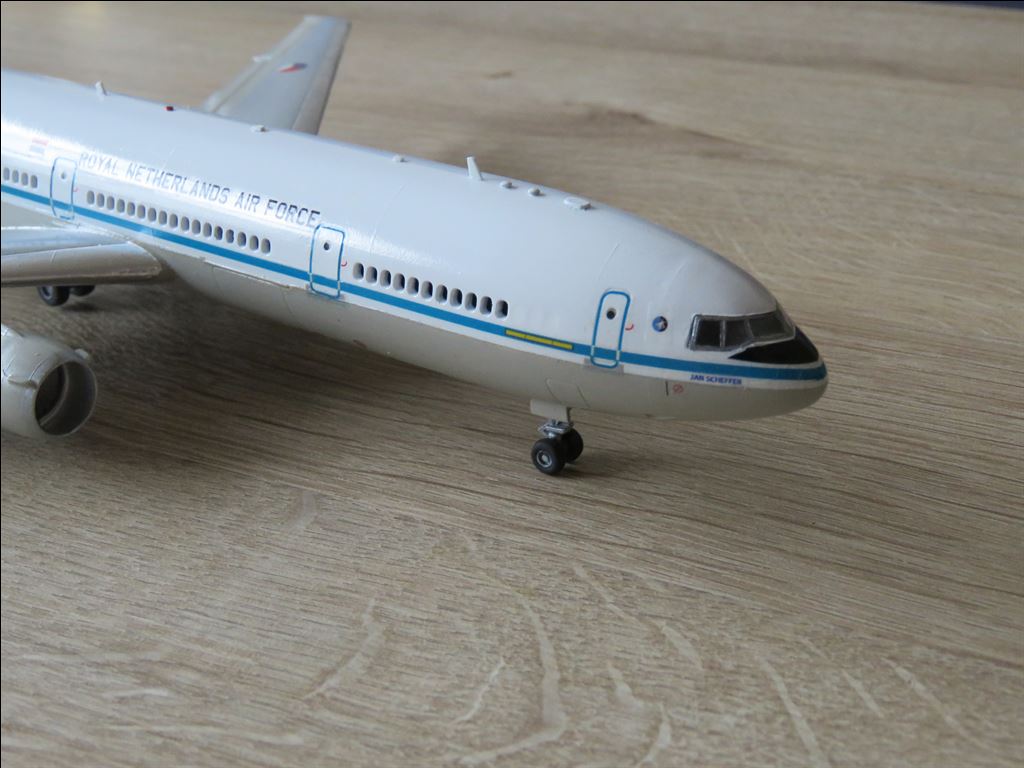
McDonnell-Douglas KDC-10: The nose with the homemade decals with the name, squadron emblem applied.

McDonnell-Douglas KDC-10: Side view. The model was finished as T-235 with the anniversary markings with 60 Years 334 squadron. The decals are homemade. It turned out that the decals for the registrations in the kit were not correct (wrong font), but just right for this jubilee version.
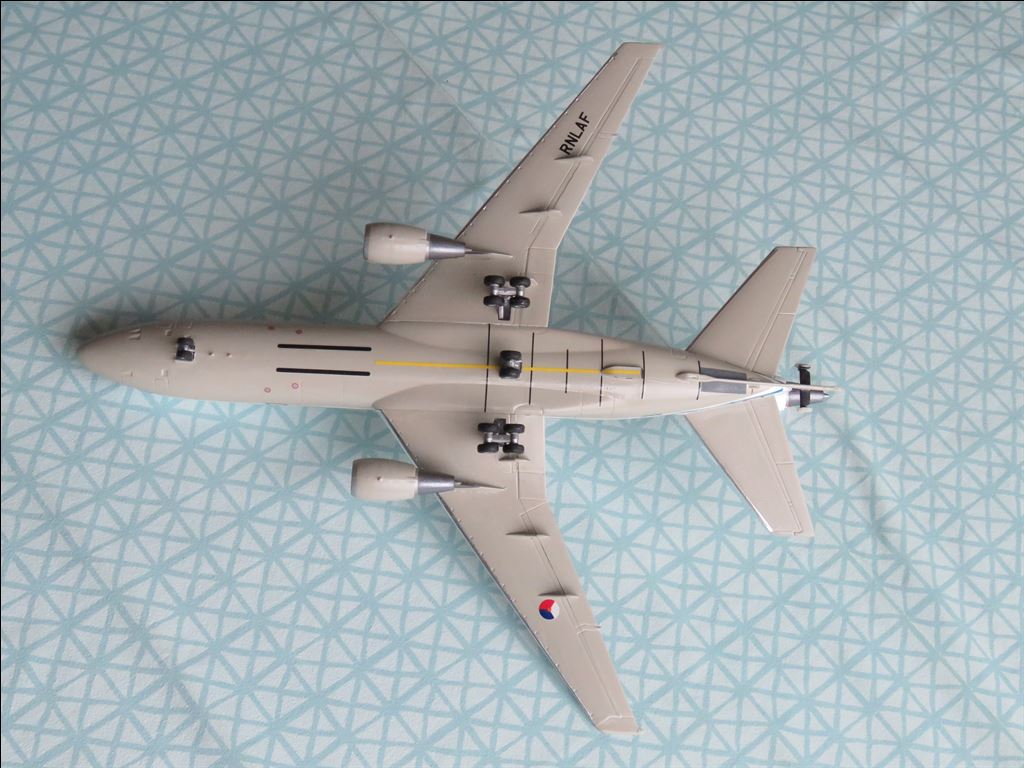
McDonnell-Douglas KDC-10: The undersides.
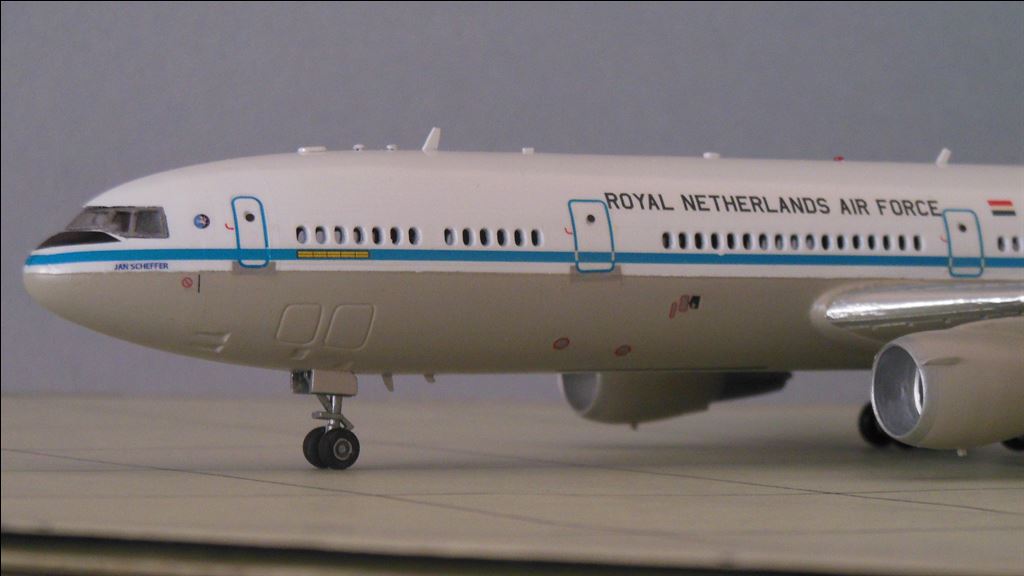
McDonnell-Douglas KDC-10: Nose in left side view
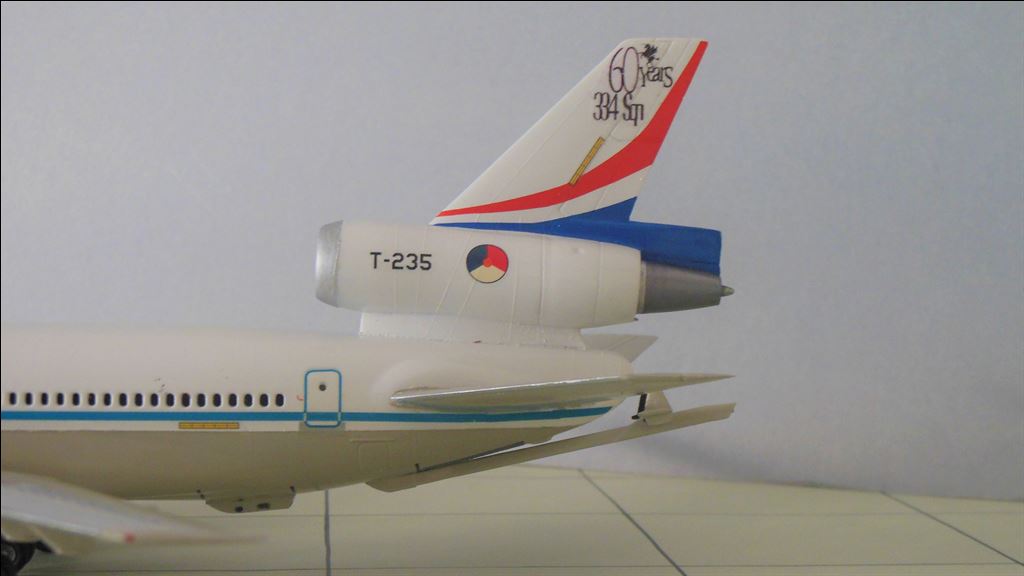
McDonnell-Douglas KDC-10: The tail with hmemade jubilee markings clearly visible here.
Modelling add-on
- --
- Set --: --
Decals
- --
- Set --: --
1/48th Scale
Kits
- --
- Kit --: --
Modelling add-on
- --
- Set --: --
Decals
- --
- Set --: --
| Scheme | Colour name | FS number | BS-number | Humbrol | XtraColor | Vallejo ModelColor | Vallejo ModelAir | |
|---|---|---|---|---|---|---|---|---|
| Delivery scheme: white roof; light grey lower surfaces. | ||||||||
| Standard #1: | Undersides | Grey | ~6440 | 129 | X137 | 70.990 | - | |
| Upper surfaces | White | ~7875 | 9010 | 130 | 70.951 | - | ||
| Grey scheme since 2004 | ||||||||
| Standard #2 | Upper surfaces | Dark Grey | ~6173 | 156 | 70.992 | - | ||
| Undersides | Light grey | ~6440 | 129 | X137 | 70.990 | - | ||
Check www.paint4models.com for an extensive conversion table with lots of colour and paint systems.
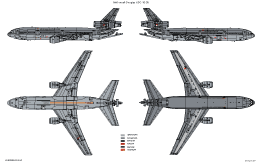
The second, overall grey scheme with the later applied black markings on the McDonnell-Douglas KDC-10-30.
Literature.
| Squadrons van de Koninklijke Luchtmacht (derde herzien druk) | Willem Helfferich | Pag. 64 - 66 | 1994 | Uitgevers Wyt, Rotterdam |
| Modelbouw in Plastic jaargang 12, nummer 2: DC-10; Gevecht met de KLM-DC-10-30 van Revell. | Ron van Basten | Pag. 52 - 55 | 1983 | Uitgever: I.P.M.S. Nederland, Nederland |
| Luchtvaart; 11e jaargang nummer 5: De KDC-10 'Dutch Extender' | Herman Sixma & Theo van Geffen | Pag. 224 - 231 | 1994 | Uitgeverij Ten Brink, Meppel |
| AVIA;40e jaargang nummer 7: McDonnell Douglas DC-10 | Bart van der Klaauw | Pag. 283 - 291 | 1981 | Uitgevers Wyt, Rotterdam |
Websites.
- Wikipedia UK: McDonnell-Douglas DC-10
- PlaneSpotters.Net: McDonnell-Douglas DC-10
- TaxiWays.DE: McDonnell-Douglas DC-10
- Airliners.net: McDonnell-Douglas DC-10
- Aircrafts.nl: McDonnell-Douglas DC-10
- KLU.Tigerteam: McDonnell-Douglas DC-10
- Luchtmacht.nl: McDonnell-Douglas DC-10
- KDC-10 transporting medical team to Asia .
- KDC-10 transports rescue team to disaster area Haiti
- Defensie.nl: McDonnell Douglas KDC-10
Special thanks to mr S. Scheffers, RNlAF for supplying me with the information about the (K)DC-10-30. Furthermore, my thanks go to Léon Charmant who provided the article about the development.

